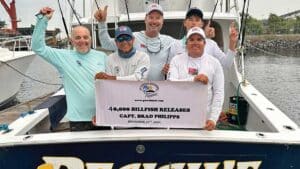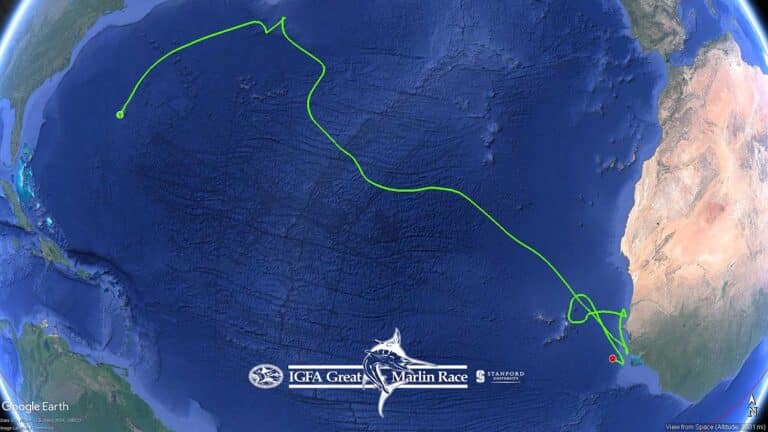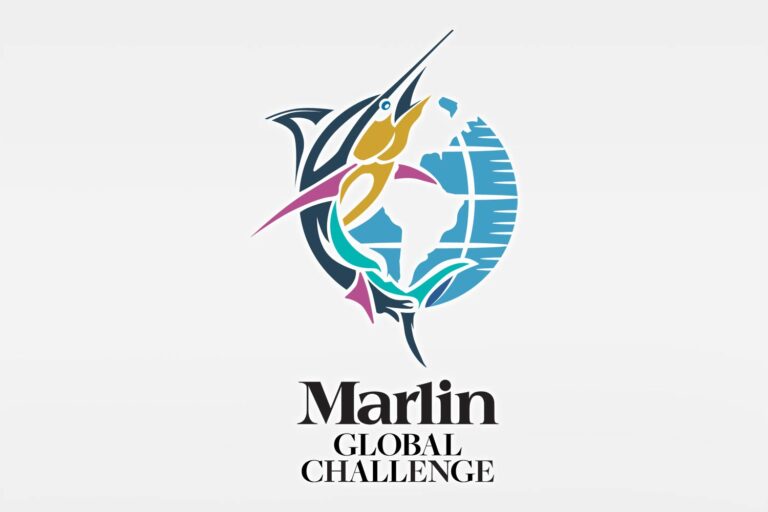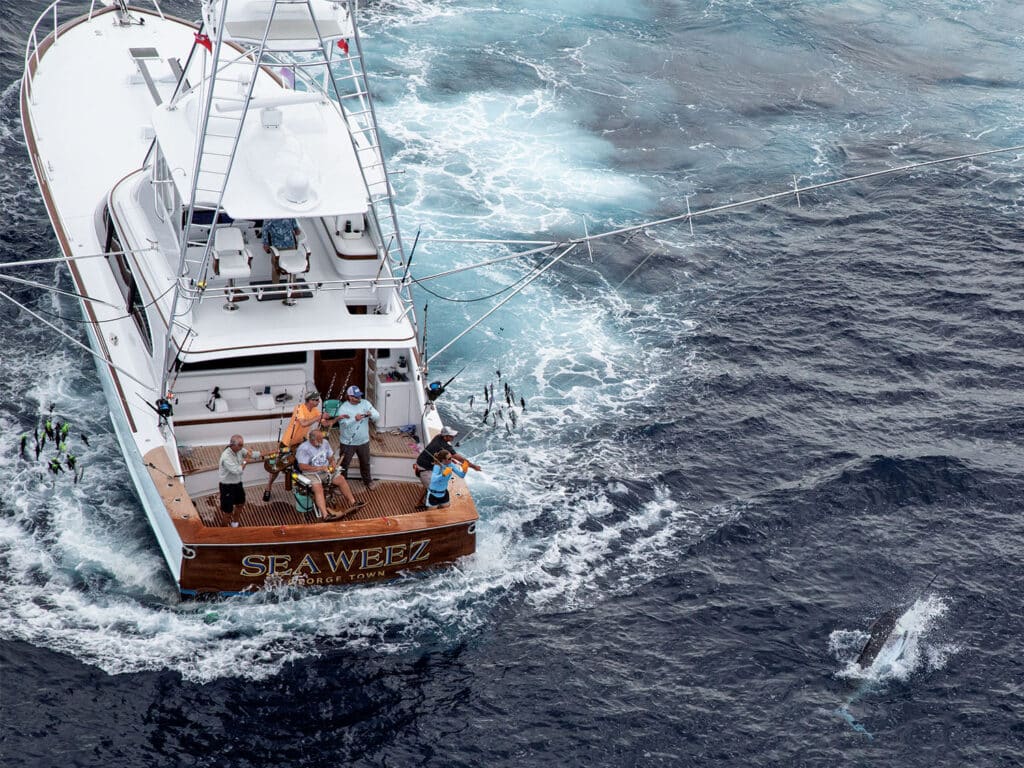
Special delivery: Sign up for the free Marlin email newsletter. Subscribe to Marlin magazine and get a year of highly collectible, keepsake editions – plus access to the digital edition and archives.
Wow, would you just look at that bottom structure! You reckon there’s a couple of big marlin there?” Capt. Ross Finlayson asks rhetorically as he stares down at the Navionics chart on his phone. The area that’s gotten his attention is one of the many banks and seamounts off the coast of the Azores, where he plans to take the 67-foot Ricky Scarborough Sea Weez the following year.
This Portuguese chain of islands is known as a late-summer haunt for giant blue marlin and is almost a perfect antipode from where Finlayson has spent the majority of his career in the legendary waters of Australia’s Great Barrier Reef. It wouldn’t take many fingers to count the number of active captains who have caught more marlin over 800 pounds than Finlayson, but the allure of the upcoming adventure still transfixes him.
On this day, he’s sitting in the salon of Sea Weez in Cape May, New Jersey, packing up as the Northeast portion of the season finishes up and he prepares to move the boat back to Scarborough for a quick dry dock. The canyon season has produced some blue and white marlin, but with overall slow fishing for the fleet, Finlayson’s thoughts have now moved on to preparing for his next stops to Panama and the East Atlantic, with targets on the Canary Islands and the Azores.
The long-term plan is to take Sea Weez from the Atlantic’s hotspots to the remote areas of the Pacific in search of giant marlin, with a goal of having Finlayson back on his GBR home turf within the next few years.
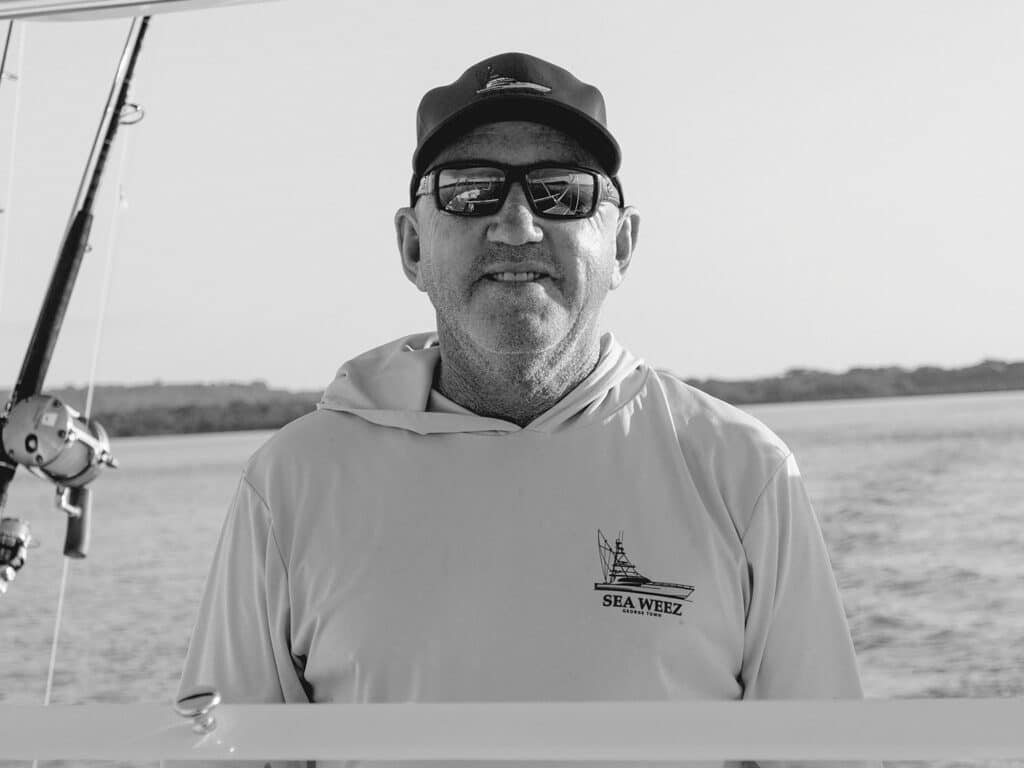
Reef Roots
Fishing on a brand-new private boat is quite a change of pace for Finlayson, who spent the previous 30-plus years as a charter captain on the Great Barrier Reef. He grew up in the Australian country town of Shepparton and began his fishing career as a crewman, ultimately overcoming his battle with seasickness and eventually working under Australian fishing legend Capt. Laurie Woodbridge on Sea Baby 4 in 1992.
The two spent seven years fishing together until health issues forced Woodbridge from the helm, asking Finlayson to take over as captain. “I still feel funny about it, really,” Finlayson says as he shakes his head. “It was a dream come true, as you can imagine. Woodbridge was a magazine figure I’d sent a letter to growing up. For a kid from Victoria to get to drive Sea Baby 4 after working for the guy, it was pretty massive.”
Climbing into the captain’s chair earlier than he planned, Finlayson took to the job quickly, earning the trust of the GBR clientele by starting with day trips and getting creative to build a charter base of his own. He and the late Capt. Billy Bilson were among the first captains from the Cairns fishery to utilize the internet for advertising, which paid dividends in drumming up business during the early days.
After spending 15 years on Sea Baby 4 as captain and crewman, Finlayson would go on to run a 43-foot O’Brien called Top Shot for approximately 10 years, and then another 43-foot O’Brien, Bounty Hunter, for two more seasons. During that time, he became one of the top captains on the reef, with 10 weighed granders, plus plenty more size-large models released. Nine of those granders were over 1,100 pounds, with the largest weighing 1,260. Among his other accomplishments, Finlayson’s impressive resume also includes winning the prestigious Lizard Island Marlin Tournament three years in a row, and a black marlin world record on 50-pound-class tackle for Stephanie Choate that pushed the scales to an incredible 1,111 pounds.
Nick Cortezi, like many others making the pilgrimage to Cairns in search of a grander, was one of Finlayson’s Top Shot charters. “I had heard of Ross and was lucky enough to get introduced to him by Capt. Laurie Wright,” he says. “And that first week fishing with him was great. Somebody who was with me fought a marlin the crew estimated to be about 1,200 pounds, fighting it for at least four hours into the dark. Unfortunately, we broke it off just before getting the leader, which was heartbreaking, but the opportunity to see that fish and watch that challenge was astounding. That’s what really set the hook in me.”
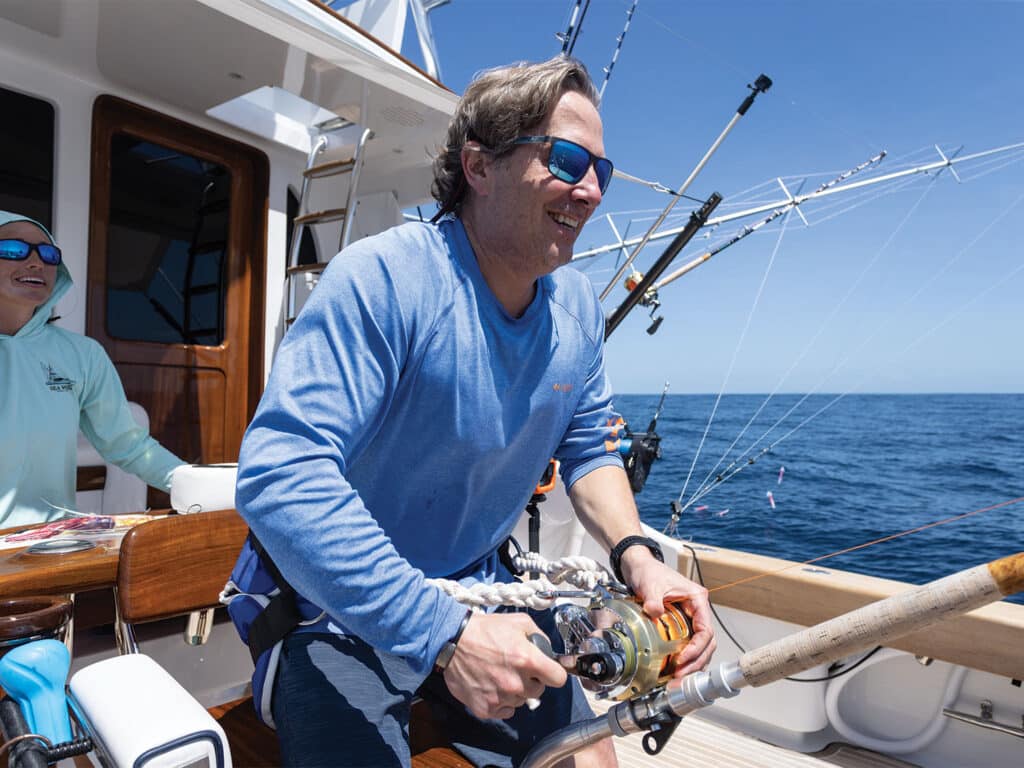
After 33 years in the insurance-underwriting business, which involved frequent travel for work, Cortezi sold his business and decided it was time for his travel to be centered on pursuing the hobbies that he and his family enjoy most: fishing, surfing and diving. He’d tossed around the idea of building a boat with Finlayson over their last couple of fishing trips, and with a bond created through their time fishing the Great Barrier Reef together, Cortezi knew that he was the man for the job. “Going back year after year, I got to know Ross and see how he runs a boat, how he manages his crew, and how he treats the clients,” Cortezi explains. “He sets a very high standard for the role, and keeps himself, the crew and the boat performing at an exceptionally high level—all while making it look effortless.”
Finlayson jumped at the opportunity. When his Australian season ended that year, the next thing he knew, he was flying to North Carolina to look at custom boats. The pair decided that Ricky Scarborough Jr. was a match for the build, and the Sea Weez program came to life over the next couple of years.
The Boat
Sea Weez splashed in January 2021 and was purpose-built just as Cortezi and Finlayson intended: designed to chase large marlin in some of the most remote areas in the world. Sea Weez is the 12th hull built by the junior Scarborough and sports twin 12V 2,000 hp MAN engines that can push her to about 43 knots wide open. The boat has a four-stateroom, three-head layout to make the boat comfortable for living, and holds some 2,300 gallons of fuel and 300 gallons of water. An 18-foot Chittum skiff rests on the foredeck for flats and inshore fishing, along with a davit to launch the skiff and potentially weigh fish in remote destinations. There’s also an air compressor to fill dive tanks, as well as enough storage space for surfboards and all the gear necessary to explore off the beaten path. Finlayson added a few custom fishing features, such as a livewell and tuna tubes in the transom, where you’d traditionally find a kill box, and an Aussie-style brine tank for prepping large skip baits.
Anchoring was also high on Finlayson’s list of priorities, with his many years of liveaboard trips on the Great Barrier Reef to lay the groundwork. The tower, built by Palm Beach Towers, is often used by Finlayson when navigating around a new anchorage, and the bow rail, also a Palm Beach Towers design, gets some funny looks in the States, Finlayson says. “Everyone here hates the bow rail. But let me tell you, when you anchor up on a place like the Great Barrier Reef and it’s raining and blowing 30 knots at night, the crew is glad to have it when they go to lift the anchor or watch for bommies. Palm Beach Towers did a fantastic job of making it look sexy while maintaining its functionality.”
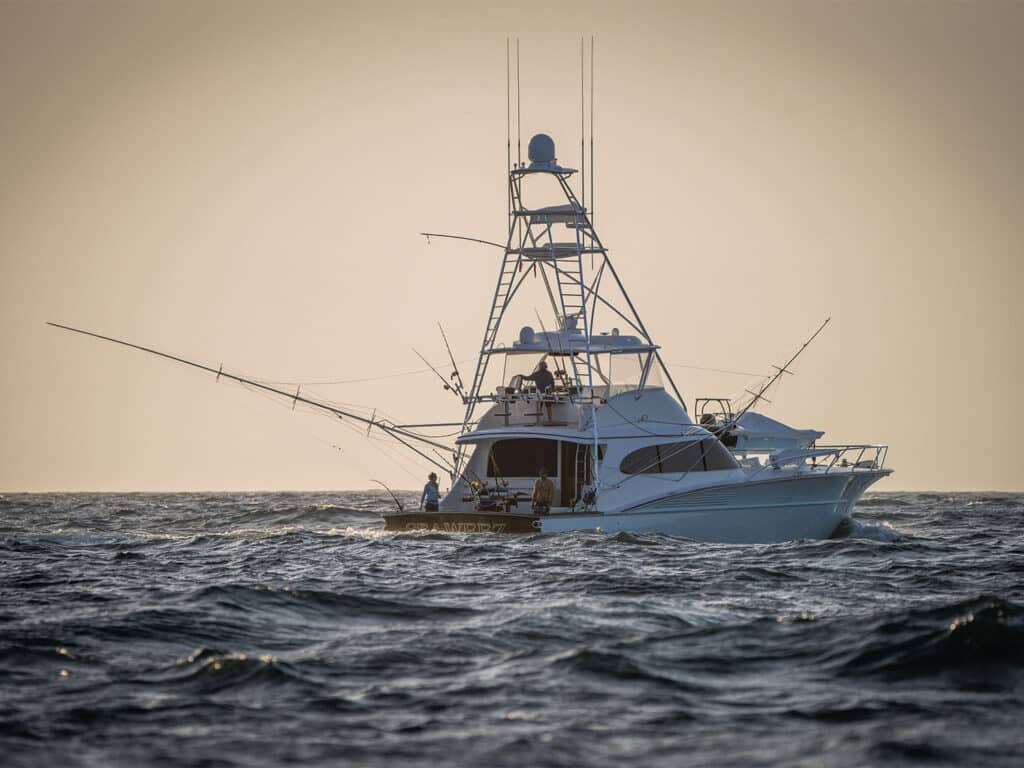
Let the Tour Begin
Since fishing out of North Carolina, the Bahamas, two stints in Panama, and another two in New Jersey, Sea Weez’s next journey will take her across the Atlantic to begin a tour of the best big-fish destinations in earnest, with coordinated stops in meccas such as the Canary Islands, Madeira and the Azores. The plan is to stay in the East Atlantic for two seasons before the crew sets its sights on the Pacific, with Australia and Tahiti—and anywhere that marlin swim, for that matter—as possibilities among the primary targets. Cortezi also recently purchased a 147-foot Cheoy Lee superyacht, which will be called Limited Risks, to act as a mothership and support vessel for the Scarborough. “I think the long-term plan is to turn this into a semi-charter operation, where people who are really passionate about large billfish have the opportunity to charter for a week or two somewhere super remote and have it be entirely self-contained,” Cortezi says.
While the ambitious Sea Weez schedule has the crew fired up, there’s always something special about catching big fish in your backyard, and it’s no different for Finlayson. “We’re going over to the East Atlantic to fish for the big blue marlin that live there, and I can tell you that when I see that first giant one, I’ll be saying that I don’t want to leave,” Finlayson says with a laugh. “But for me, my heart always belongs with huge black marlin. So that’s what I’m really looking forward to the most—getting back to Australia and fishing for the blacks, especially doing it comfortably on a big, modern 67-footer.”
In addition to catching big marlin, the Sea Weez team also plans to help the scientific community learn more about fish patterns through satellite tagging. Cortezi has purchased satellite tags from the IGFA that will provide invaluable information on many data points, such as migration patterns and depth range. While this technology has been around for a while, the crew hopes to deploy these tags in areas where migration information might not be as abundant. They have already placed satellite tags in two fish off Panama: an estimated 800-pound blue marlin off Zane Grey Reef and a black around 350 pounds from Hannibal Bank.
Finlayson hopes that they can sat-tag fish when they reach the South Pacific, which will help complete the puzzle of where the big blacks that return to the Great Barrier Reef spend the remainder of their time. “I’m hoping there’s a honey hole that we could find out there somewhere,” he says. “I don’t know if you’d find them with the consistency that we do during the marlin season in Cairns, but I like the thought that there might be somewhere else out there like that.”
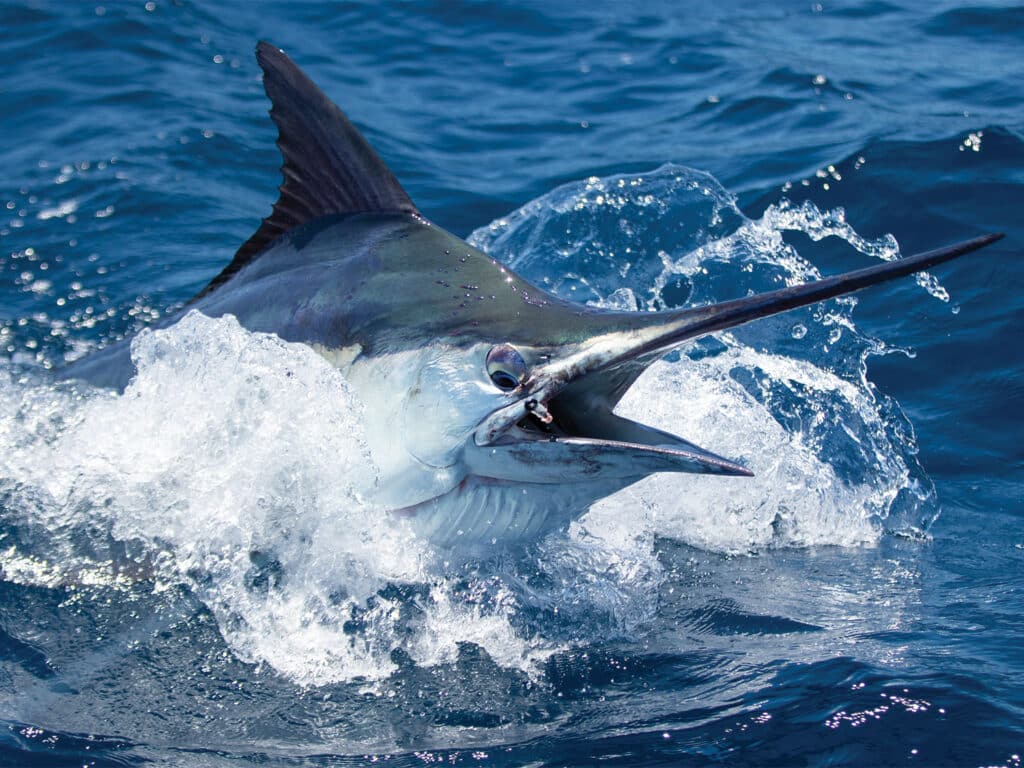
Cortezi is also excited about the prospect of getting back to where it all began for his family and Finlayson by bringing things full circle with Sea Weez. The team hopes that Finlayson’s local knowledge and years of experience, coupled with the boat’s modern technology, will create a deadly combination on the fabled black marlin grounds off Cairns.
So far, Sea Weez has successfully served her purpose as a serious sport-fisher that the entire Cortezi family has been able to enjoy, with much more on the horizon. “One trip that already sticks out is taking my wife (whom the boat is named after) and two of her friends for an afternoon trip with Ross and having all three of them catch their first blue marlin in an afternoon,” Cortezi recalls. “I had to let them know that was not a typical day of marlin fishing in most places.”
Read Next: Check out Capt. Karl Anderson’s feature on handling close calls at sea.
With many of the world’s best big-game fishing destinations on the schedule and a mothership about to join the program, the journey has only just begun for Sea Weez. While still poring over charts of the Azores, Finlayson looks up and relays a feeling that most fishermen can relate to at any scale: “It’s like finding a barramundi spot in the river. You know there are heaps of big ones on it, but you also know somewhere else there’s another one, and you’ve just got to go looking. You’re just always looking to fish around the next bend in the river to see what’s there.”
